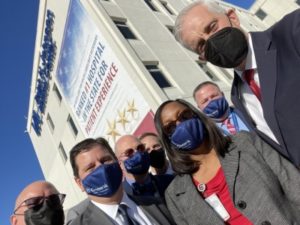Healthcare System Has Kept Staffing Stability During Pandemic

The announcement of the new staffing plan came last month during a visit by VA Secretary Denis McDonough, right, to the Ralph Johnson VAMC in Charleston, SC. Here he is shown with VAMC staff and officials. VA photo from Twitter feed
WASHINGTON – VA recently unveiled a 10-step human infrastructure plan designed to strengthen the department’s ability to recruit and retain staff. The plan focuses on raising wages where it can and finding other incentives to help VA compete with the private sector when increasing pay isn’t possible.
The announcement came last month during a visit by VA Secretary Denis McDonough to the Ralph Johnson VAMC in Charleston, SC.
“I don’t think there’s anything that I’m more proud of than the fact that, in the midst of a pandemic, VA didn’t weaken or slow down,” McDonough declared during his remarks to facility employees. “No, VA got stronger and took care of vets when they needed it most. And that’s why I’m here today: to recognize all you’ve done and discuss what your country is doing to invest in you.”
During the first year of the pandemic, as for-profit medical centers were facing a loss of revenue from canceled procedures and consequently cutting staff, VA remained relatively stable. It even became a destination for healthcare employees who viewed the federally-funded healthcare agency as a safe harbor in uncertain times.
This, combined with pandemic-related legislation that allowed the department to bring on employees quickly when they needed to, insulated VA in some part from the staffing losses felt elsewhere. However, with the provisions in that pandemic legislation expiring or already expired, VA hopes to make some of the speedy hiring provisions permanent.
That is one of the items in the 10-point plan. The others include: waiving bonuses for work done during the pandemic and increasing retention incentives; offering greater flexibility to employees to work outside the office whenever possible; raising the income cap on childcare subsidies from $89,000 to $149,000; investing in scholarship programs and working with President Biden on loan forgiveness; and working with Congress to raise the federal worker minimum wage to $15 an hour and to pass the RAISE Act.
The VA Nurse and Physician Assistant Retention and Income Security Enhancement (RAISE) Act would increase the pay limitation on nurse and physician assistant salaries. PAs and advanced practice nurses could earn up to $226,300 annually and RNs could early $203,700. Those positions are currently capped at $176,300.
Nurses and PAs have long been areas where VA has experienced persistent staffing shortages, and the situation will likely only get worse in the near future with so many VA nurses eligible to retire. McDonough has said he expects VA will need to hire 15,000 nurses every year for the next five years in order to fill demand.
This will happen at a time when the entire country will be facing a shortage of healthcare workers. The Association of American Medical Colleges (AAMC) predicts a shortage of up to 124,00 physicians by 2034 and that the country as a whole will need to hire 200,000 nurses per year to meet demand.
Layered on top of this is the fall-out from the pandemic and what’s being termed The Great Resignation. A survey of 1,000 medical professionals conducted by Morning Consult, a business intelligence company, in October 2021, found that 18% had quit their jobs during the pandemic and an additional 31% were thinking of quitting. Many cited the burnout and stress from an already short-staffed workplace and poor treatment by employers during the pandemic.
While the RAISE Act would directly impact salary caps, much of the rest of VA’s staffing plan is designed to bolster the department’s benefits package and what they can offer potential employees beyond a high salary.
Federal law dictates a maximum cap on federal employee’s base salary. To compensate, VA has had to find other ways to lure high-demand specialist physicians to its facilities. That includes scheduling and telework flexibility, the ability to continue teaching while employed at VA, as well as a robust benefits package.
Areport created by the Veterans Healthcare Policy Institute in 2020 suggests, however, that the salary cap remains a significant barrier to recruitment.
“The pay rate for VA employees is further complicated by the fact that the VA is often unable to compete effectively with the private sector,” the report states. “A VA facility chief of staff noted that an interventional radiologist or cardiothoracic surgeon could easily earn more than $500,000 in the private sector. According to the VA’s OIG, VA hospital directors make roughly 25% less than their private sector counterparts, yet many hold greater responsibilities. Although working at the VA offers many rewards unavailable in the private sector–like the opportunity to work with and give back to veterans, avoid the hassles of dealing with insurance companies, and deliver truly coordinated care–they may not always compensate for the high cost of living in many urban areas. To cite one particularly stark example, the Palo Alto VA Health Care System is grappling with a whopping 984 vacancies, in large part because potential staff are unable to afford a home in the region, which averages nearly $2.5 million.”
To complicate matters, the top non-clinical job vacancy across the department is in human resource management.
Despite these difficulties, McDonough and lawmakers are hopeful that they can craft new legislation that can overcome them.
“Veterans deserve the best possible care and these measures will empower the nation’s largest healthcare system to hire and keep the best doctors, nurses, and frontline medical staff on its payroll,” declared Sen. Jon Tester (D-MT). “I look forward to unveiling new legislation that will build on the administration’s efforts.”
